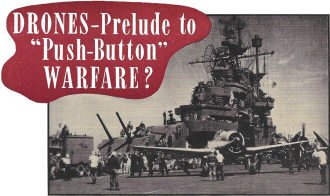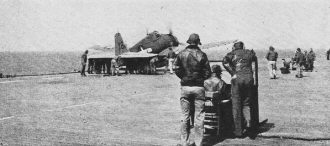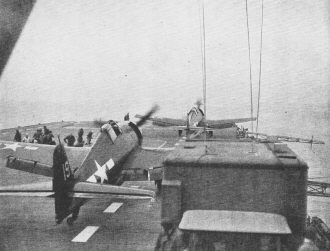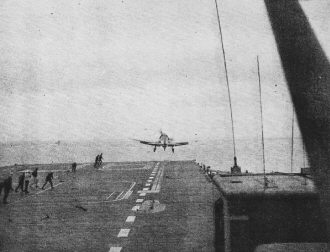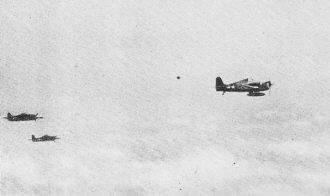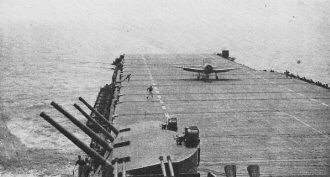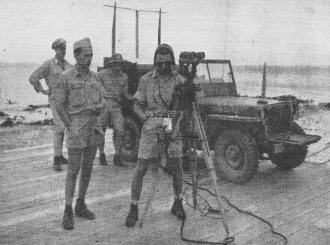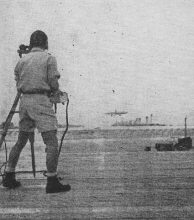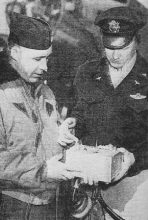Drones - Prelude to "Push-Button" Warfare? |
|
The term "drone" is relatively new to being common parlance throughout society. Prior to the early 2000s, a drone was thought of as either the mate to a queen bee or a special remotely controlled aircraft used by the military for target practice or for carrying out special missions not deemed safe for human pilots. When this article appeared in a 1952 issue of Radio & Television News magazine, drones were the exclusive purview of the military and research institutions because of high procurement and operational costs. With the advent of inexpensive, highly advanced spread spectrum radio control systems by the hobby community, lightweight and powerful brushless motors and lithium polymer (LiPo) batteries, sophisticated miniature stability and guidance integrated circuits (processors and sensors), and advanced computer simulation, incredibly capable and relatively inexpensive multirotor drones are widely available. From simple toys for erstwhile non-pilots to serious R/C flyers to professional operators, drones are everywhere. A couple days ago I saw a utility company worker using one to inspect power lines along a country road. At the same time, military uses have grown significantly as well, serving as surveillance platforms, for supply delivery, and as weapons launching vehicles. Atomic bombs "on the wing," guided swiftly and surely by radio to their target threaten mankind in war. By Oliver Read, Editor, Radio News It takes no crystal gazer to foresee wholesale destruction of cities by A-Bombs in future warfare. Those of us who witnessed the detonations at Bikini are quite in agreement that any future war will be fought with "guided missiles." When a man combines two sciences, such as electronics and nuclear physics and perfects means for controlling their destructive powers he becomes a dangerous guy to have around. The sterling performance of the radio-controlled planes at Operation-Crossroads is very convincing evidence that we have at our fingertips a basically simple media for conducting highly successful airborne A-Bomb attacks on an enemy. I spent a great deal of time studying both Army and Navy drones while attending the Bikini tests. In fact, I had the thrilling experience of flying from Eniwetok to Kwajalein, a distance of over 300 miles, in one of the Army's B−17 drones. Crew connects launching mechanism for F6F Hellcat. Takeoff "control chair" operator (foreground) stands by. Its 90·foot run completed, the "mother" ship takes to the air at full throttle into the wind. She will stand by to take over control of her drone. Drone aircraft missions in the Pacific Ocean. Ready to go - the first drone waits for its "mother" to pass overhead and "take control" after it has left the flight deck. I was stationed aboard the aircraft carrier, U.S.S. Shangri−La on and before A-Day and had a ringside seat to observe and record the operation of the Navy drones (see front cover). As mentioned in my article last month, Navy drones were catapulted from the flight deck of the Shangri−La as we headed into the wind and in the direction of the target. It was part of Admiral Blandy's plan to send these Navy fighters into the cloud at various altitudes in order to obtain samples of the radioactive particles and to record other vital information needed by the scientists. Map indicates route of Army (shown in blue) and Navy planes and ships that were active during the first atomic bomb test. Army drones took off and returned to Eniwetok Island. while Navy drone planes took off from the ship Shangri−La and returned to their land base on Roi Island. Navy F6F Hellcats catapulted from the Shangri−La, streaked into the cloud first, followed by the Army B−17 drones. All but one of the drones were returned safely to their base after completing their historic atom bomb mission. The Navy employed a total of twenty F6F Hellcats. Sixteen of them were "mother" or control ships and the other four were the participating drones. The Navy system was to have two of the "mother" ships send the drone into the cloud while two more, assigned to each drone, circled on the far side of the cloud to pick up the drone as it came through and to guide it by radio to the island of Roi, located approximately 178 miles distant. The Hellcat is a single-seater fighter type of aircraft. There is little room available, therefore, for "extra equipment." Hence, the Navy had to utilize the small area directly in back of the pilot's chair. As a matter of fact, there appeared to be more than enough room for the necessary control equipment. The radio system includes a receiver containing separate filters for 10 audio channels. These are highly sensitive in their ability to discriminate between various audio frequencies. A total of ten channels are employed for the control of the aircraft. Selsyn motors are connected to the various controls such as the throttle, elevators, etc. by means of relatively simple mechanical gadgets to simulate the efforts of the pilot (if there were one). These planes have been controlled successfully within a radius of better than 150 miles. The entire radio control equipment weighs barely more than the average pilot so the normal maneuverability of the ship is not changed in any way whatsoever. Each drone carried a special installation consisting of a small air sample bag and Geiger counters. Radioactive cloud material entered this, small bag through a radio-controlled port that opened when an impulse was sent to the drone by the "mother" ship. Geiger counters were also carried in each drone and "mother" craft to record the amount of radioactivity present in the area and to warn control pilots. In some cases this information was transmitted by radio to the observers and scientists on various vessels within the Task Force. On Able-Day minus one we witnessed the final checking of all control and mechanical equipment of the entire drone group. Spare drones were kept in readiness should they be needed. Launching cable has been hooked on to this drone and the pilot has "deserted" ship after checking all controls. Until the plane is airborne it will be controlled from the carrier flight deck. On the morning of "A" or "Able-Day" I arose bright and early in order that I could have sufficient time to set up my portable wire recorder at a point of vantage where I could see both fore and aft as well as to look directly down on the flight deck. I finally selected a bridge high up on the superstructure, directly under the several radar antennas. I was able to get well over an hour's recording of the historical event. This tiny spool of wire has now become one of my most valued possessions. While awaiting the takeoff of the first of the "mother" ships I learned that the first Navy drones were used back in 1936. Later several B-24s were controlled by radio. This was in 1944. The Hellcats arrived with the Shangri−La and the first rehearsal took place on June 10th, followed by two more on June. 24th. The first two tests were conducted under the scrutiny of the pilots who stood by at the controls should it be necessary for them to take over. The June 24th rehearsal however, was carried out minus the pilots and the drones were airborne without personnel. The first to take off on A-Day were the sixteen "mother" ships. They were thoroughly warmed up prior to take-off and were catapulted at thirty second intervals from the two ninety-foot catapults built into the flight deck. Impulses from the radio truck have the drone under perfect control. Crew rushes forward to "make ready" the next drone plane which will be launched. Two "mothers" lag behind and send drone into cloud. Two other "mother" planes on the far side of the atom cloud pick up drone and return it to Roi Island. Landing at 20 second intervals, the first of ten "mother" planes sets down after completing its mission of guiding the drone planes. Mission completed. This pilot taxis his ship forward to park. Another plane will follow in twenty seconds. Ground control positions for the Army B−17 drones. Powerful binoculars on top of the tripod permit the "ground pilot" to view the incoming plane which he is controlling by means of the electronic "joy stick" housed in the small box attached to the tripod. Radio transmitter which controls the plane is in jeep. Cockpit of a B−17 drone. Selsyn motors operate controls by radio signals sent by "mother" plane. Shortly thereafter the first of the drones was secured in place on catapult No.1. The pilot then left the ship which he had taxied to position. After closing the cowling it was ready to go. Two of the "mother" ships which had been circling in the area, came in over the flight deck and, at exactly the right moment, "took over" control of the drone. The drones are controlled on take-off from the radio control truck parked and tied securely down to the flight deck. Long cables extend from the truck to the controlling chair, as shown in the illustrations. The chair operator has a control box at his fingertips which functions in much the same manner as does the control mechanism on the plane. He is able to maneuver the ship during its take-off and while it is airborne as long as he can observe the behavior of the craft while in flight. The rest of the drones were soon on their way to the target area and things quieted down considerably. We had now reached point Tare and our drones were on their way to sections V and S where they were to circle in readiness for the run into the cloud. The four drones had attained altitudes of 10,000, 15,000, 20,000 and 28,000 feet. We were listening to the communications channels including the direct commentary (140 mc.) from the bomber. I was able to hear and to record many transmissions from the command ship, from Kwajalein, from various aircraft in flight, and from other units engaged in the test. The drone flying at 20,000 feet got away from its control ships after passing through the cloud and streaked toward Tokyo at approximately 400 m.p.h. It was tracked by radar as its "mother" ships took up the chase and was finally brought under control 53 minutes later and returned to Roi. The automatic pilot on the 28,000 ft. drone failed before the drone was able to enter the cloud and went down to Davey Jones locker. This was the only drone lost in the operation. The other drones, having passed safely through the cloud, were picked up by their "mother" ships and returned safely to Roi. One of them was so radioactive that it was parked well out in the clear and all personnel were kept away. As a matter of fact, it was not possible to examine the ship for many days following. It is interesting to note that the drones could have all been returned to the Shangri−La if there had been no danger of radioactivity. Under the circumstances however, this would have been disastrous to the personnel aboard. Close-up view of control position as plane is landed by radio control from the ground. Major D.H. Whittaker and Col. Harvey T. Alness examine the control box which is used to guide B−17 drones in landing. Tail section of B−17 showing some of the radio control equipment in place. I mentioned earlier that I had flown in one of the Army drones. The B−17s gave an excellent account of themselves during the test. Their job was to gather similar material to that of the Navy drone only on a large scale. Having more space, heavy equipment and larger air sample bag could be installed. The latter was built into the right bomb bay while the air port was built into the belly of the ship and operated in a manner similar to that on the Hellcats. The Army, too, uses a 10 channel system. The Army Drone Unit was organized on March 15, 1946 at Clovis, New Mexico, and consisted of ten drones and six "mothers," The drone unit arrived at Eniwetok April 29th and immediately began its rehearsals for the Bikini operations. There were a total of four drones and four "mothers." Operation is as follows: A "mother" ship takes off with manual control and circles the airstrip while its drone is taxied to position. The No. 1 control operator is positioned on a platform on the leeward end of the strip. The radio control equipment is installed in a small Army truck parked on the platform. The operator looks directly down the runway through a transit similar to a surveyor's instrument. His job is to control the rudder, brakes and. throttle during take-off. A second control position, known as No.2, is situated on the side of the strip approximately 200 yards ahead of the No. 1 position. The ground radio equipment is installed in two vehicles. The No.2 operator controls the elevators of the drone during take-off as he is in a better position to observe the climb of the ship. (When landing, the No. 2 operator controls both elevators and throttle.) Two television cameras are installed in each B−17 drone plane. One of them is mounted in the nose of the ship and the other is located in a wood box enclosing the instruments of the ship. Within this box are several automotive type headlamp bulbs used for illumination of the instruments. Operators at the No. 2 control have at their disposal two television receivers. They are able to observe the airspeed, pressure, altitude, manifold pressure, oil pressure, and the flux gate compass of the drone while it is airborne. The other televiser gives "eyes" to the drone. The operators on the· ground can observe the target or whatever is ahead of the plane. The television system worked extremely well. In fact, I was able to see myself looking into the nose television receiver on the ground, while one of the drones which was televising the area, came in for its landing. The B−17 "mother" ships were also equipped with radar. After witnessing the sensational performance of both the Army and Navy drones, it becomes quite obvious that the perfected A-Bomb of the future would be carried and directed to its target entirely by radio controlled drones. Yes, a "push-button" war is possible. The most important job now is to develop counter-control equipment.
Posted April 25, 2022 |
|

